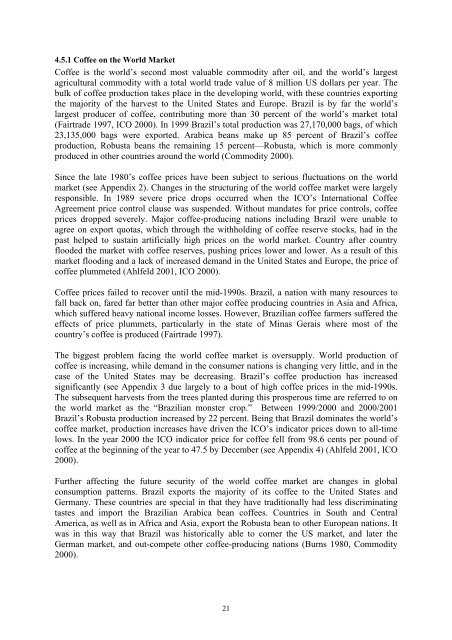Deforestation, Coffee Cultivation, and Land Degradation ... - lumes
Deforestation, Coffee Cultivation, and Land Degradation ... - lumes
Deforestation, Coffee Cultivation, and Land Degradation ... - lumes
You also want an ePaper? Increase the reach of your titles
YUMPU automatically turns print PDFs into web optimized ePapers that Google loves.
4.5.1 <strong>Coffee</strong> on the World Market<strong>Coffee</strong> is the world’s second most valuable commodity after oil, <strong>and</strong> the world’s largestagricultural commodity with a total world trade value of 8 million US dollars per year. Thebulk of coffee production takes place in the developing world, with these countries exportingthe majority of the harvest to the United States <strong>and</strong> Europe. Brazil is by far the world’slargest producer of coffee, contributing more than 30 percent of the world’s market total(Fairtrade 1997, ICO 2000). In 1999 Brazil’s total production was 27,170,000 bags, of which23,135,000 bags were exported. Arabica beans make up 85 percent of Brazil’s coffeeproduction, Robusta beans the remaining 15 percent—Robusta, which is more commonlyproduced in other countries around the world (Commodity 2000).Since the late 1980’s coffee prices have been subject to serious fluctuations on the worldmarket (see Appendix 2). Changes in the structuring of the world coffee market were largelyresponsible. In 1989 severe price drops occurred when the ICO’s International <strong>Coffee</strong>Agreement price control clause was suspended. Without m<strong>and</strong>ates for price controls, coffeeprices dropped severely. Major coffee-producing nations including Brazil were unable toagree on export quotas, which through the withholding of coffee reserve stocks, had in thepast helped to sustain artificially high prices on the world market. Country after countryflooded the market with coffee reserves, pushing prices lower <strong>and</strong> lower. As a result of thismarket flooding <strong>and</strong> a lack of increased dem<strong>and</strong> in the United States <strong>and</strong> Europe, the price ofcoffee plummeted (Ahlfeld 2001, ICO 2000).<strong>Coffee</strong> prices failed to recover until the mid-1990s. Brazil, a nation with many resources tofall back on, fared far better than other major coffee producing countries in Asia <strong>and</strong> Africa,which suffered heavy national income losses. However, Brazilian coffee farmers suffered theeffects of price plummets, particularly in the state of Minas Gerais where most of thecountry’s coffee is produced (Fairtrade 1997).The biggest problem facing the world coffee market is oversupply. World production ofcoffee is increasing, while dem<strong>and</strong> in the consumer nations is changing very little, <strong>and</strong> in thecase of the United States may be decreasing. Brazil’s coffee production has increasedsignificantly (see Appendix 3 due largely to a bout of high coffee prices in the mid-1990s.The subsequent harvests from the trees planted during this prosperous time are referred to onthe world market as the “Brazilian monster crop.” Between 1999/2000 <strong>and</strong> 2000/2001Brazil’s Robusta production increased by 22 percent. Being that Brazil dominates the world’scoffee market, production increases have driven the ICO’s indicator prices down to all-timelows. In the year 2000 the ICO indicator price for coffee fell from 98.6 cents per pound ofcoffee at the beginning of the year to 47.5 by December (see Appendix 4) (Ahlfeld 2001, ICO2000).Further affecting the future security of the world coffee market are changes in globalconsumption patterns. Brazil exports the majority of its coffee to the United States <strong>and</strong>Germany. These countries are special in that they have traditionally had less discriminatingtastes <strong>and</strong> import the Brazilian Arabica bean coffees. Countries in South <strong>and</strong> CentralAmerica, as well as in Africa <strong>and</strong> Asia, export the Robusta bean to other European nations. Itwas in this way that Brazil was historically able to corner the US market, <strong>and</strong> later theGerman market, <strong>and</strong> out-compete other coffee-producing nations (Burns 1980, Commodity2000).21
















